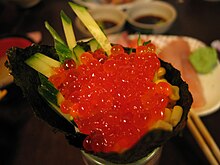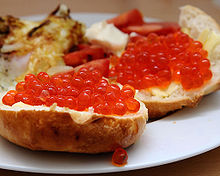Red caviar
You can helpexpand this article with text translated fromthe corresponding articlein Russian.(April 2024)Click [show] for important translation instructions.
|
You can helpexpand this article with text translated fromthe corresponding articlein Japanese.(May 2018)Click [show] for important translation instructions.
|


Red caviaris acaviarmade from theroeofsalmonidfishes (various species ofsalmonandtrout), which has an intense reddish hue. It is distinct fromblack caviar,which is made from the roe ofsturgeon.[1]
Red caviar is part ofRussianandJapanese cuisine.InJapan,salmon caviar is known asikura(イクラ) which derives fromRussianwordikra(икра) which means caviar or fish roe in general.[1]
In Japanese cuisine, it is usually marinated in salt orsoy sauceandsake.The seasoning used varies from household to household. Many families pickle red caviar using only soy sauce, but some usedashiinstead of sake ormirin.[2]
Russiansenjoy red caviar appetizers (zakuski) on buttered bread[3]or on ablini(Slaviccrêpes).[4]Caviar on blini may be paired with sliced salmon and champagne, especially on such occasions asRussian New Year's Eve.[5]
References
[edit]- ^abNichola Fletcher,Caviar: A Global History(Reaktion Books,2010), p. 90–91.
- ^"いくら の 醤 dầu mỡ け Hokkaido | うち の hương thổ liệu lý: Nông lâm nghiệp thủy sản tỉnh".maff.go.jp.Retrieved2020-08-13.
- ^Guzeva, Alexandra (2020-12-29)."5 dishes every Russian has on their New Year table".rbth.Retrieved2021-04-19.
- ^"These Russian Blinis are Perfect for New Year's Eve | The Nosher".My Jewish Learning.23 December 2020.Retrieved2021-04-19.
- ^"Blini with caviar: a sophisticated way to spoil yourself".The Spectator.8 January 2021.Retrieved2021-04-19.
- ^Bledsoe, G.E.; Bledsoe, C.D.; Rasco, B. (May 2003)."Caviars and Fish Roe Products".Critical Reviews in Food Science and Nutrition.43(3): 317–356.doi:10.1080/10408690390826545.ISSN1040-8398.PMID12822675.S2CID35039858.
- ^Saeki, Hiroki; Shimizu, Yutaka; Takeda, Hirofumi (2022),"Fish roe products of Japan",Fish Roe,Elsevier, pp. 211–242,doi:10.1016/b978-0-12-819893-3.00004-7,ISBN9780128198933,retrieved2022-12-09
- ^UEDA, Tatuhiro (1951)."On the Theoretical Coefficients of Performance of Multi-Medium and Multi-Stage Compression Refrigerating Cycles".Transactions of the Japan Society of Mechanical Engineers.17(62): 78–83.doi:10.1299/kikai1938.17.62_78.ISSN0029-0270.


